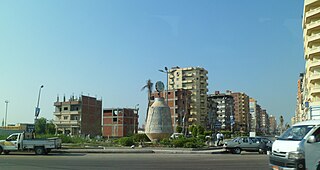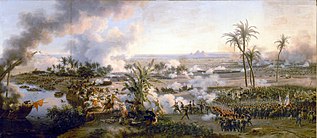kom Hamada كوم حمادة | |
|---|---|
 Kom Hamada Protal | |
| Coordinates: 30°45′45″N30°41′50″E / 30.76250°N 30.69722°E | |
| Country | |
| Governorate | Beheira |
| Population (2006) | |
• Total | 418,227 |
| Time zone | UTC+2 (EST) |
Kom Hamada is a city in Beheira Governorate in Egypt.
kom Hamada كوم حمادة | |
|---|---|
 Kom Hamada Protal | |
| Coordinates: 30°45′45″N30°41′50″E / 30.76250°N 30.69722°E | |
| Country | |
| Governorate | Beheira |
| Population (2006) | |
• Total | 418,227 |
| Time zone | UTC+2 (EST) |
Kom Hamada is a city in Beheira Governorate in Egypt.
After the French campaign arrived to the west of Alexandria on July 2, 1798, AD, they marched into the city and occupied it and then by Napoleon took a march on Cairo through Damanhur, where he was able to occupy Rosetta on July 6 and reached Rahmaniyah, a village on the Nile, during which the Mamluks were preparing an army to confront The French armies led by Murad Bey, where the two armies met near Shubra Khit on July 13, 1798, CE. [1]
Kom Hamada has a population of 41,227, of whom 19,169 are male and 22,058 are female, according to the 2006 official census. [2]

The French Revolutionary Wars were a series of sweeping military conflicts resulting from the French Revolution that lasted from 1792 until 1802. They pitted France against Great Britain, Austria, Prussia, Russia, and several other countries. The wars are divided into two periods: the War of the First Coalition (1792–1797) and the War of the Second Coalition (1798–1802). Initially confined to Europe, the fighting gradually assumed a global dimension. After a decade of constant warfare and aggressive diplomacy, France had conquered territories in the Italian Peninsula, the Low Countries, and the Rhineland due to its very large and powerful military, which had been totally mobilized for war against most of Europe with mass conscription of the vast French population. French success in these conflicts ensured military occupation and the spread of revolutionary principles over much of Europe.

The War of the Second Coalition was the second war targeting revolutionary France by many European monarchies, led by Britain, Austria, and Russia and including the Ottoman Empire, Portugal, Naples and various German monarchies. Prussia did not join the coalition, while Spain supported France.

Sharqia Governorate is the third most populous of the 27 governorates of Egypt. Located in the northern part of the country, its capital is the city of Zagazig.

The Roman Republic was a sister republic of the First French Republic that existed from 1798 to 1799. It was proclaimed on 15 February 1798 after Louis-Alexandre Berthier, a general of the French Revolutionary Army, had occupied the city of Rome on 11 February. It was led by a Directory of five men and comprised territory conquered from the Papal States. The Roman Republic immediately incorporated two other former-papal revolutionary administrations, the Tiberina Republic and the Anconine Republic. It proved short-lived, as Neapolitan troops restored the Papal States in October 1799.

Kafr El Dawwar is a major industrial city and municipality on the Nile Delta in the Beheira Governorate of northern Egypt. Located approximately 30 km from Alexandria, the municipality has a population of about 265,300 inhabitants and comprises a number of smaller towns and villages.
1798 was a relatively quiet period in the French Revolutionary Wars. The major continental powers in the First coalition had made peace with France, leaving France dominant in Europe with only a slow naval war with Great Britain to worry about. The leaders of the Directory in Paris feared Napoleon Bonaparte's popularity after his victories in Italy, so they were relieved when he proposed to depart France and mount an expedition to Egypt to gain further glory.

The Battle of the Pyramids, also known as the Battle of Embabeh, was a major engagement fought on 21 July 1798, during the French Invasion of Egypt. The battle took place near the village of Embabeh, across the Nile River from Cairo, but was named by Napoleon after the Great Pyramid of Giza visible nearly nine miles away.

During the French Revolutionary Wars, the revolutionary armies marched eastward, enveloping Switzerland in their battles against Austria. In 1798, Switzerland was completely overrun by the French and was renamed the Helvetic Republic. The Helvetic Republic encountered severe economic and political problems. In 1798 the country became a battlefield of the Revolutionary Wars, culminating in the Battles of Zürich in 1799.

Marsa Alam is a tourist town in south-eastern Egypt, located on the western shore of the Red Sea. It is described as a "popular" tourist destination. Marsa Alam is a relatively recently-built town; its development began in 1995 through the investments of the Kuwaiti Al-Kharafi Group, which established the town and its initial facilities, resorts and infrastructure. Its growth was accelerated by the opening of Marsa Alam International Airport in 2003. Due to its crystal clear water and its white sandy beaches, it is also known as the "Egyptian Maldives."
Stéphanos II Ghattas was an eparch of the Coptic Catholic Church. From 1986 to 2006 he served as the Coptic Catholic Patriarch of Alexandria. He was also a Cardinal. His canonization process has been initiated.

Léman was the name of a canton of the Helvetic Republic from 1798 to 1803, corresponding to the territory of modern Vaud. A former subject territory of Bern, Vaud had been independent for only four months in 1798 as the Lemanic Republic before it was incorporated into the centralist Helvetic Republic. Léman comprised all of the territory of Vaud detached from Bernese occupation, apart from the Avenches and the Payerne which, after 16 October 1802, were annexed by the canton of Fribourg until the Napoleonic Act of Mediation the following year when they were restored to the newly established and newly sovereign canton of Vaud.
Events from the year 1798 in Ireland.
The Egyptian General Petroleum Corporation (EGPC) is a national oil company of Egypt. EGPC's business includes crude oil exploration, refining, and storage. The company also produces lubricants and greases and offers services for oil and gas projects.

Muhammad Loutfi Goumah, was an Egyptian essayist, author, and barrister. He studied law and became one of Egypt's most famous lawyers and public speakers. He was a member of the prestigious Arab Academy of Damascus, he spoke Arabic, English, French and Italian, he also had a profound knowledge of Hieroglyphic and Latin.

The French invasion of Switzerland occurred from January to May 1798 as part of the French Revolutionary Wars. The independent Old Swiss Confederacy collapsed from the invasion and simultaneous internal revolts called the "Helvetic Revolution". The Swiss ancien régime institutions were abolished and replaced by the centralised Helvetic Republic, one of the sister republics of the French First Republic.

El Rahmaniya is a city and markaz in Beheira Governorate, Egypt.

The Piedmontese Republic was a revolutionary, provisional and internationally unrecognized government established in Turin between 1798 and 1799 on the territory of Piedmont during its military rule by the French First Republic.

The National Congress Battalions, also known as the Truppe di Campagna, was an irregular military set up in Malta just after the Maltese rebellion against French rule in September 1798. It existed for two years before being disbanded on 11 September 1800.

Parliamentary elections were held in Egypt on 24–25 October and 7–8 November 2020 to elect the House of Representatives. The election resulted in a landslide victory for the Nation's Future Party, winning 316 of the 596 seats.

El Delengat is a city in Beheira Governorate in Egypt